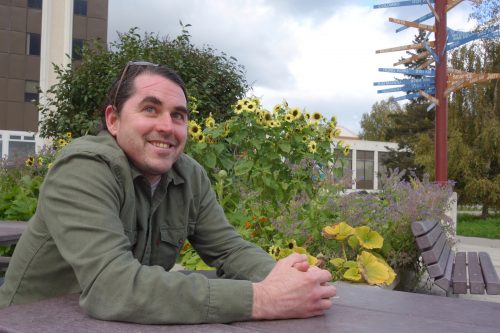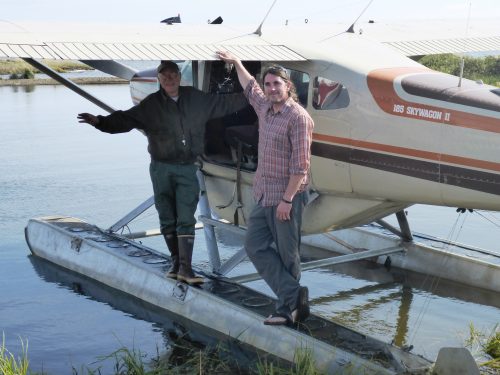Return to crash site is emotional, healing
September 9, 2020
Ned Rozell
907-474-7468

Ben Jones recently returned to the tundra site of a plane crash that in May took the life of the pilot, and left Jones bloodied and broken.
Jones is a do-it-all scientist with the Institute of Northern Engineering at the University of Alaska Fairbanks. He is inventive and opportunistic, pursuing curiosities of northern Alaska from a cabin he helped resurrect on Teshekpuk Lake starting in 2007. That cabin has become a second home for him and is now an official university research station.
In mid-May 2020, it was near there — over the snow-covered, treeless tundra — that contracted pilot Jim Webster was banking his single-engine airplane on skis for a return to the cabin. For a reason Jones does not know, the plane hit the ground hard before that turn was completed. The Cessna 185 bounced, smashed, and came to a crashing halt seconds after.
Jones remembers the impact, and suddenly skidding to a stop, the plane upside-down.
He was dazed, bleeding from his head, and his right hand hurt, but Jones was able to get out of the plane. Webster was unconscious, hanging upside down, still buckled into his seat belt.
Jones had a satellite texting device connected to his phone. The inReach disappeared during the crash, but the phone’s bluetooth signal was still reaching it. He messaged his wife Melissa in Fairbanks.

Though Jones’s fingers were too bloody and painful to swipe his phone in the manner that would activate the SOS feature, Melissa, at home in Fairbanks, alerted rescue crews from Utqiaġvik and elsewhere.
To slow his bleeding, Jones tied his UAF sweatshirt around his head and tightened it using a Velcro balaclava.
Webster had, by then, regained consciousness. He and Jones worked to unbuckle Webster’s seat belt and lower him carefully to the plane’s interior.
“Jim was conscious for 30 or 40 minutes, and we were able to talk a bit,” Jones said. “We both agreed he was doing what he loved to do, and, if he died, not many people get to go out that way.
“You could get COVID and die from this tiny little thing,” Jones said during a recent outdoor interview on the UAF campus. “He kind of wanted me to reassure him that (the crash) wouldn’t wreck (working in the far north) for me.”
After they spoke, Webster became quiet and struggled to breathe. He passed away there on a bed of wind-packed snow.
Webster, 76, had flown Jones all over that quiet swath of Arctic Alaska. Their first meeting was in summer 2007, when Webster’s plane emerged from the mist at Cape Halkett on the polar bear-filled northern coast. Webster landed on a shallow lake and picked up Jones, whom another pilot had dropped off hours before.
 The two developed a friendship, nurtured by minutes and days shared in a raw, windy
wilderness. Jones appreciated that Webster never left him while Jones was drilling
holes in lakes for water samples, fixing weather stations or taking photos of towers
of bank ice leaning toward the sea.
The two developed a friendship, nurtured by minutes and days shared in a raw, windy
wilderness. Jones appreciated that Webster never left him while Jones was drilling
holes in lakes for water samples, fixing weather stations or taking photos of towers
of bank ice leaning toward the sea.“He was totally happy camping out and sleeping in his plane,” Jones said. “He made a lot of our work possible. If he needed or wanted to sleep in a hotel, it would have added weeks to our trips.”
Webster bunked many nights in his plane while parked outside the Teshekpuk Lake cabin. He had carried Jones, his wife Melissa and his daughter Lillian to the cabin last summer. Fourteen people, including Webster, had tented outside the cabin in August 2019, using the small frame building as a communal shelter to eat and dry gear.
Jones, who is 41 and grew up in Cincinnati, said Webster enjoyed the family vibe of the place. That might have been why, with his last breaths, Webster asked Jones to promise him the accident would not prevent him from returning north.
To honor Webster’s wishes and his soul connection to a place few people will see, Jones decided to return to Teshekpuk Lake in late August 2020. There, he would work on the cabin, tend to a few scientific experiments and return to the crash site.

Jones has a finger-length crescent scar on his forehead from the crash. His right hand is, for now, bent into a claw because of broken bones and the pins a doctor installed in them. But he moves well, feels very fortunate and thought the timing was right to return to Teshekpuk Lake.
In mid-August, Jones drove from Fairbanks to Coldfoot with his wife Melissa and 1-year-old daughter. There, they would to fly to Teshekpuk Lake with Dirk Nickisch and Danielle Tirrell, who operate Coyote Air from their base near the Koyukuk River.
“I was nervous to get back in a small plane,” Jones said. “But everyone recommended Dirk as an amazing pilot, a guy who could talk me through any problems I had.”
In a De Havilland Beaver equipped with amphibious floats, Nickisch landed on expansive Teshekpuk Lake (at 500 square miles, larger than the space taken up by Los Angeles). That day, the lake was flat calm, with few ripples.
After opening the cabin to air it out, Jones noticed something: When evening sunlight slanted from the west, from the door he could see something.
“If you knew where to look, you could see the glow of yellow from the plane jutting from the tundra,” he said.
In a few days, after a good deal of silent reflection, he stepped into a Zodiac inflatable boat, leaving his wife and daughter at the cabin.
“I needed to go back there by myself,” he said.
Jones motored across the lake about 15 minutes, then nosed into shore gravel about three miles from the cabin. He then hiked over the bumps of the landscape.
He reached the remains of the plane, scattered over several hundred yards.

There, Jones remembered his friend and their last moments together. He found Webster’s glasses, his baseball hat and his jacket. He placed those items with care into a duffel bag. He would later hand them to Webster’s wife, Joan, whom Jones and his family visit often in Fairbanks.
At the crash site, Jones also propped parts of the plane on wooden two-by-sixes. He raised the wreckage so it would not become frozen to the ground this fall. He hopes to take the pieces out by snowmachine and sled this winter, or perhaps help enlist a helicopter company to help him return it to Interior Alaska.
As he listened to the wind whistle through tundra plants and sheet metal, he thought back on his friend and how the accident might — or might not — change his life.
“I haven’t experienced a ton of anxiety or post-traumatic stress, maybe because Jim and I could talk (after the crash),” Jones said. “It’s still a shitty situation, but the fact we could talk about stuff there was helpful mentally.
“The support of so many family, friends, colleagues and strangers inside and outside of Alaska has helped, too.
“It felt good to go out and pick up the pieces,” he said.
Since the late 1970s, the University of Alaska Fairbanks' Geophysical Institute has provided this column free in cooperation with the UAF research community. Ned Rozell is a science writer for the Geophysical Institute.


